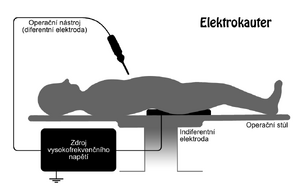Electrocautery
It is a device that works with high-frequency electric current. It is used for the treatment of soft tissues (in dentistry – gums, mucosal eyelashes)
Usage[edit | edit source]
- coagulation,
- incision,
- incision with simultaneous coagulation.
Electrotomy and electrocoagulation[edit | edit source]
These methods use the thermal effects high-frequency electric currents. If the different electrode has the shape of a tip or a narrow blade, a high current density will be created on it. When this electrode comes into contact with the tissue, the thermal effects will be so great that the water in the cells evaporates, and they are disrupted. The high temperature results in the coagulation of tissue and blood proteins, so that the electrotomy cut does not bleed. The operating frequency of electrotomy devices is ~3 MHz, power adjustable from 0–500 W. The shape of the cutting electrode is different depending on the purpose of use.
- Electrotomes with power up to 50 W are used in ophthalmology and dentistry.
- Devices with higher powers are used in abdominal surgery a traumatology.
Devices for electrotomy are usually equipped with separate electrodes for performing electrocoagulation. Its principle consists in closing the bleeding vessel by coagulation of proteins at high temperature.
Links[edit | edit source]
References[edit | edit source]
- HRAZDIRA, Ivo – MORNSTEIN, Vojtěch. Lékařská biofyzika a přístrojová technika. 1. edition. Brno : Neptun, 2001. 396 pp. ISBN 80-902896-1-4.

